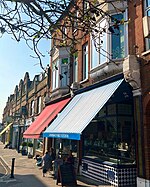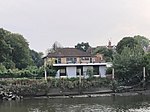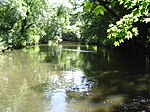Kilmorey Mausoleum

The Kilmorey Mausoleum, in St Margarets in the London Borough of Richmond upon Thames, is a Grade II* listed mausoleum in the style of an ancient Egyptian monument and has been described as a "fine example of an Egyptian-style mausoleum, with an unusually good interior". Designed by Henry Edward Kendall Jr. (1805–85) and built, at a cost of £30,000, in pink and grey granite with a bronze door, it was commissioned in the 1850s by the 2nd Earl of Kilmorey (1787–1880) and contains the bodies of the Earl and his mistress, Priscilla Anne Hoste (1823–54). Priscilla died of heart disease on 21 October 1854, and she was buried in the mausoleum, with the inscription "Priscilla, the beloved of Francis Jack, Earl of Kilmorey". When Kilmorey himself died in June 1880, aged 92, he was buried beside her in the mausoleum underneath a bas-relief in white marble showing the dying Priscilla on a couch surrounded by her lover and ten-year-old son Charles (b.1844). The bas-relief was carved in Rome by portrait sculptor Lawrence Macdonald.
Excerpt from the Wikipedia article Kilmorey Mausoleum (License: CC BY-SA 3.0, Authors, Images).Kilmorey Mausoleum
St Margarets Road, London St Margarets (London Borough of Richmond upon Thames)
Geographical coordinates (GPS) Address Nearby Places Show on map
Geographical coordinates (GPS)
| Latitude | Longitude |
|---|---|
| N 51.46112 ° | E -0.32288 ° |
Address
St Margarets Road
St Margarets Road
TW1 1NJ London, St Margarets (London Borough of Richmond upon Thames)
England, United Kingdom
Open on Google Maps









